At this time last year, we took a step back during the busy year-end season to give a high-level view of where the nonprofit industry stood in that moment. We heard from many of you that this information was helpful in your long-term planning, so we thought we'd do it again this year.
As we close out 2023, RKD's experts have identified eight major trends that are affecting nonprofit fundraising:
1. Charitable giving is decreasing once again.
- 2020 and 2021 brought a boom in nonprofit fundraising, reversing the pre-pandemic trend of declining participation and a narrowing donor pyramid.
- 2022 saw a notable weakness in both revenue and number of donors across the charitable giving space.
- Reports throughout 2023 showed a continuation of that trend, including a 10% drop in donors on GivingTuesday.
- A recent survey by The Chronicle of Philanthropy of 1,000 fundraisers revealed “notable apprehension as development professionals grapple with inflation, staffing issues, and donors’ worries about the economy.”
Conclusion: What initially appeared to be a regression to the mean after COVID is now starting to look like trouble brewing. This isn’t a time to panic, but it is necessary to be aware of what’s happening and adapt accordingly.
2. Inflation has left its mark on charitable giving.
- Individual giving grew 4.0% from 2020 to 2021, but it actually dropped -0.7% when inflation is factored in. From 2021 to 2022, individual giving declined 3.4% in current dollars and 10.5% after adjusting for inflation.
- Consumer prices (food, housing, energy, transportation) rose 13.3% from January 2021 to June 2022. That 13.3% adds up to $717 out of pocket each month for U.S. households.
- Inflation began to cool off in July 2022 and continued to fall through November 2023.
- Despite improving numbers, the public still has a downbeat view of the economy due to “collective trauma.”
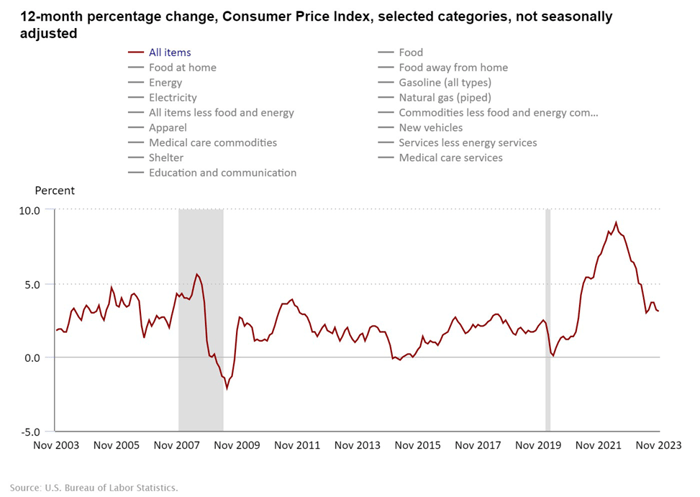
Conclusion: The impact of inflation is real, but it appears to be slowing down to more familiar levels. It will take time for people to get used to the new (higher) prices for goods and services, including the need for larger charitable gifts.
3. Trust has become an issue for nonprofits.
- Trust is a global problem in society right now. People don’t know who they can trust—government, media, politics, technology—and we are extremely polarized. We don’t even trust each other.
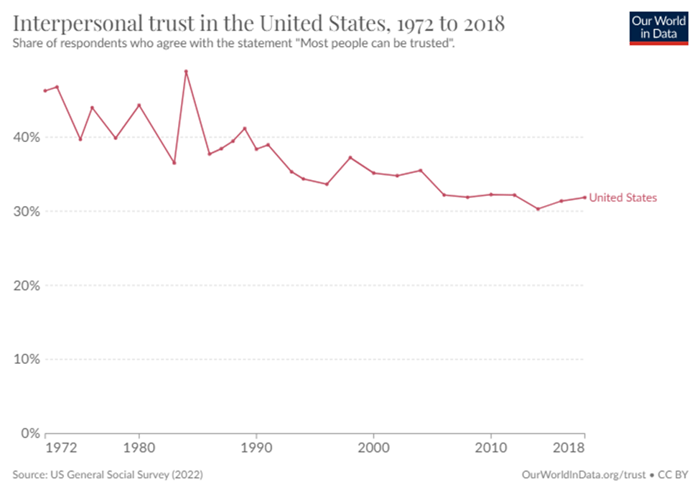
- In 2022, nonprofits fell below business for the first time in the Edelman Trust Barometer. Edelman found that trust in nonprofits dropped another 4 points in 2023.
- 52% of Americans trust nonprofits, which means 48% don't.
- People trust local organizations far more than large institutions
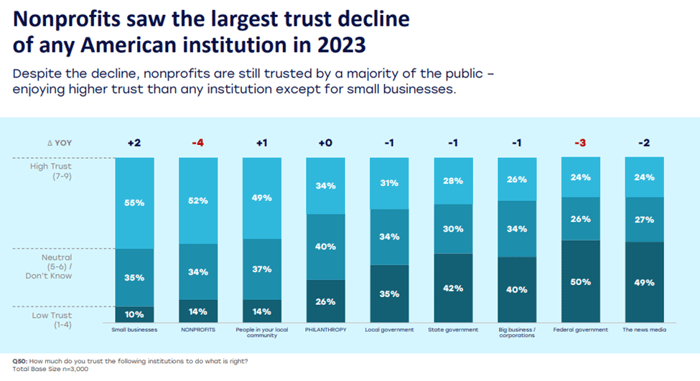
Conclusion: Nonprofit organizations must find ways to rebuild trust with donors going forward. In 2023, RKD Group surveyed 1,630 U.S. donors to gain a deeper understanding of what forces drive trust. Read our findings here.
4. Decline in faith continues across the U.S.
- Faith-based nonprofits must navigate through even more challenging headwinds. According to the Pew Research Center:
- 1972: 90% of Americans identify as Christian
- 2020: 64% of Americans identify as Christian
- 2070: 35-54% of Americans identify as Christian (projected)
- At the same time, the number of “nones” is rapidly rising:
- 1972: 5% of Americans are religiously unaffiliated
- 2020: 30% of Americans are religiously unaffiliated
- 2070: 34-52% of Americans are religiously unaffiliated (projected)
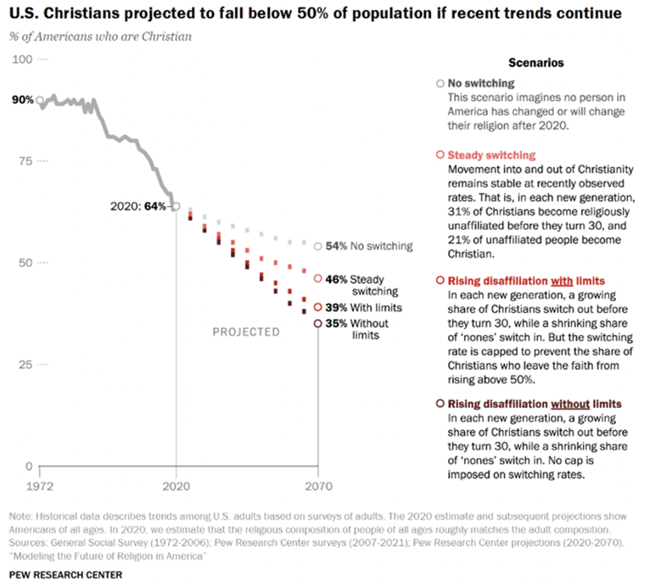
- Research shows that religiously affiliated people are generally more charitable:
- 62% of households in which members regularly attend worship give to charities
- 46% of households with no religious affiliation give to charities
- Faith-based and faith-inspired organizations make up 46% of the 1.45 million nonprofits in the U.S. They represent 4 out of every 10 international-aid groups and account for 40 percent of spending on social services.
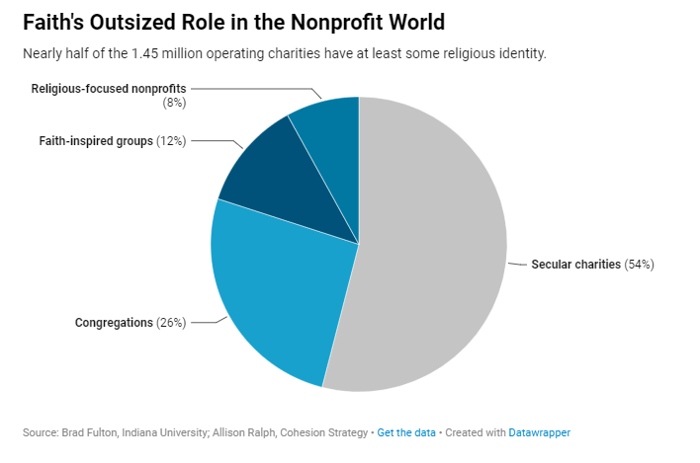
Conclusion: As views on religion continue to shift in the U.S., faith-based fundraisers must shift as well. They need to listen to their donors, reach them where they are and have the courage to think outside the box. RKD's Duke Smith shares more in this blog post.
5. Low response continues to be a challenge, especially among new donors.
- According to the Fundraising Effectiveness Project (FEP), the number of donors industrywide fell for the ninth straight quarter in Q3 2023.
- Donors were down 7.6%
- New donors were down 16.9%
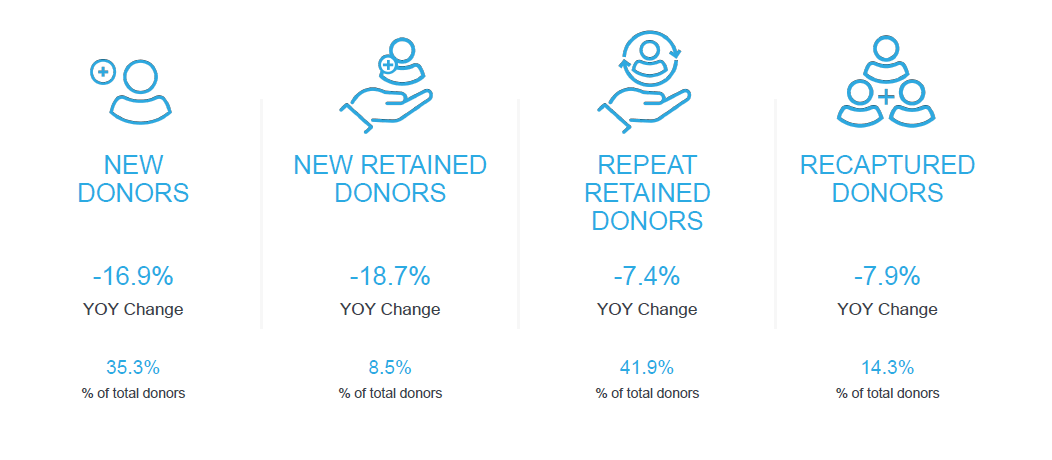
Source: Fundraising Effectiveness Project Q3 2023 Report
- Our own mid-year benchmarks show similar acquisition challenges from January to June:
- Rescue mission new donors: -16.1%
- Animal welfare new donors: -27.4%
- Food bank new donors: -16.9%
Conclusion: The same old approach to acquisition isn’t working anymore. Nonprofit organizations need to optimize their efforts in order to reduce costs and use those savings to diversify into new channels. RKD’s Anne Lobban has more recommendations here.
6. Direct mail remains an essential piece of fundraising.
- Direct mail is core to nonprofit fundraising for mature nonprofits—and the market is expected to continue to grow annually.
- Direct mail provides an exceptionally strong ROI, and RKD research shows that nonprofit marketers rank it as highest among the tools in their arsenal:
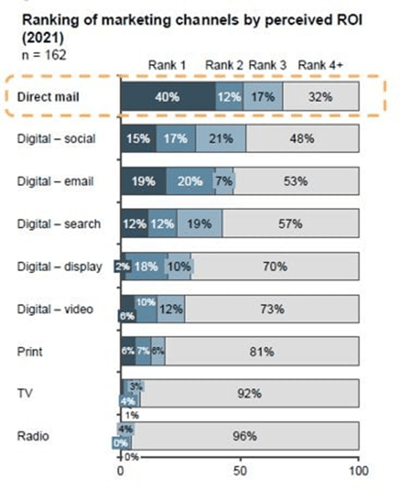
- Direct mail's tangibility carries emotional weight and substance. According to the USPS:
- 55% of people say they "look forward" to seeing what’s in their mailbox.
- 56% of people find print-based marketing to be the most trustworthy type of marketing.
- 70% of people agree that direct mail feels more personal than digital methods.
- This bodes well for direct mail, especially when trying to reach younger generations. Look at how much each generation looks forward to read the mail each day:
- 79% Millennials
- 72% Gen Z
- 70% Baby boomers
- 70% Gen X
Conclusion: Direct mail’s foundational strength and continued relevance in a crowded digital-driven environment supports its staying power in nonprofit marketing.
7. But the rapid rise of digital fundraising cannot be ignored.
- McKinsey estimates that the COVID pandemic accelerated digital adoption by three years. Just looking at customer interactions in North America reveals this to be true:
- 41% were digital in Dec. 2019
- 65% were digital by July 2020, just seven months later
- Nonprofits have seen incredible digital growth in recent years. According to Blackbaud, online giving increased by 42% from 2018-2021. In fact, 12% of all giving now happens online, up from 8.7% in 2019.
- This lines up with consumer behavior that shows 13.9% of U.S. sales are now happening online.
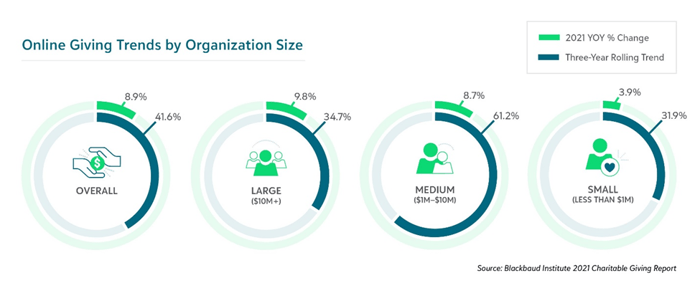
Conclusion: Don’t wait any longer to advance your digital programs to adapt to these rapid changes. Get the most out of your digital platforms by building effective fundraising strategies that integrate with your direct mail programs.
8. Generative AI is here—but how do we navigate?
- The big breakout trend in 2023 was generative AI. By mid-April, 22% of workers said they were regularly using it in their work.
- But there is a lot of noise in the AI space. Consider this map of generative AI companies:
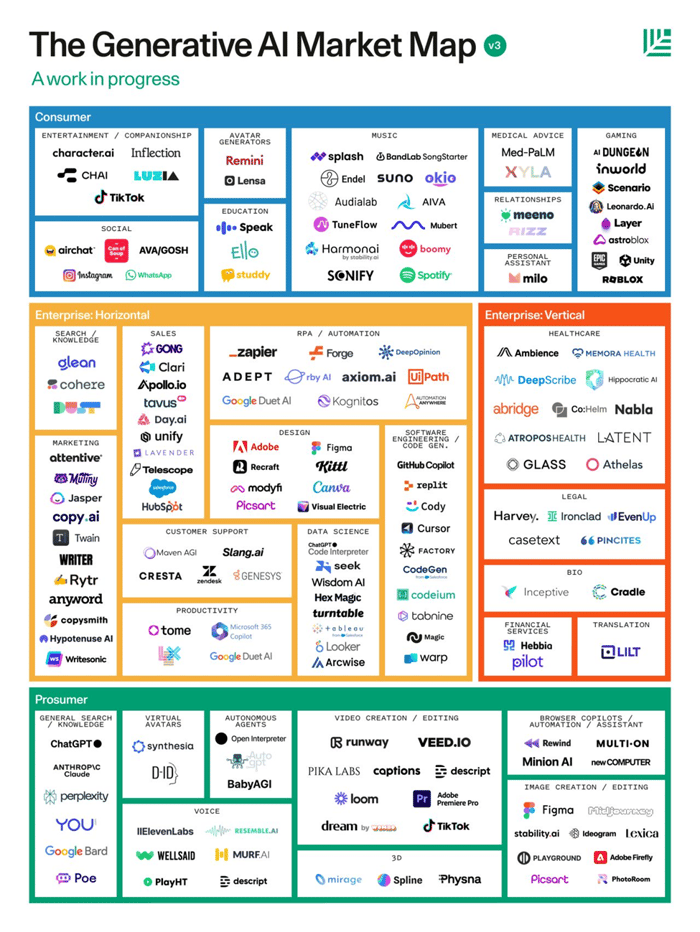
- In October 2023, Fundraising.AI held the first gathering of nonprofit professionals to exclusively explore the role of Responsible AI in fundraising.
- For some quick ideas to start, AI can help fundraising in the following areas:
- Projections and predictions
- Text, image and video generation
- Segmentation and automation
Conclusion: AI received a lot of buzz in 2023, and the technology can help nonprofits in many ways. The key to getting started (if you haven’t already) is to be open to experimentation … and failure. Don’t let perfect get in the way of progress. Find ways for AI to amplify the talents within your organization, not replace them. Check out a few ways to begin here.

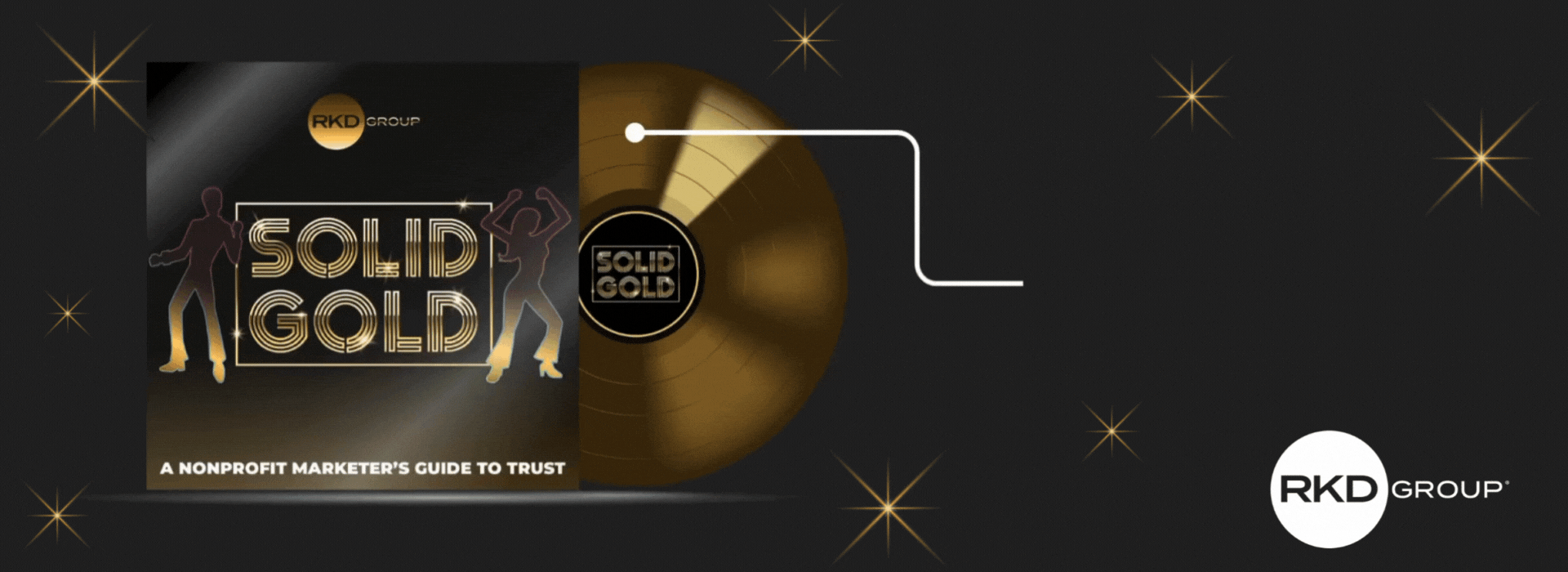




Leave a comment: